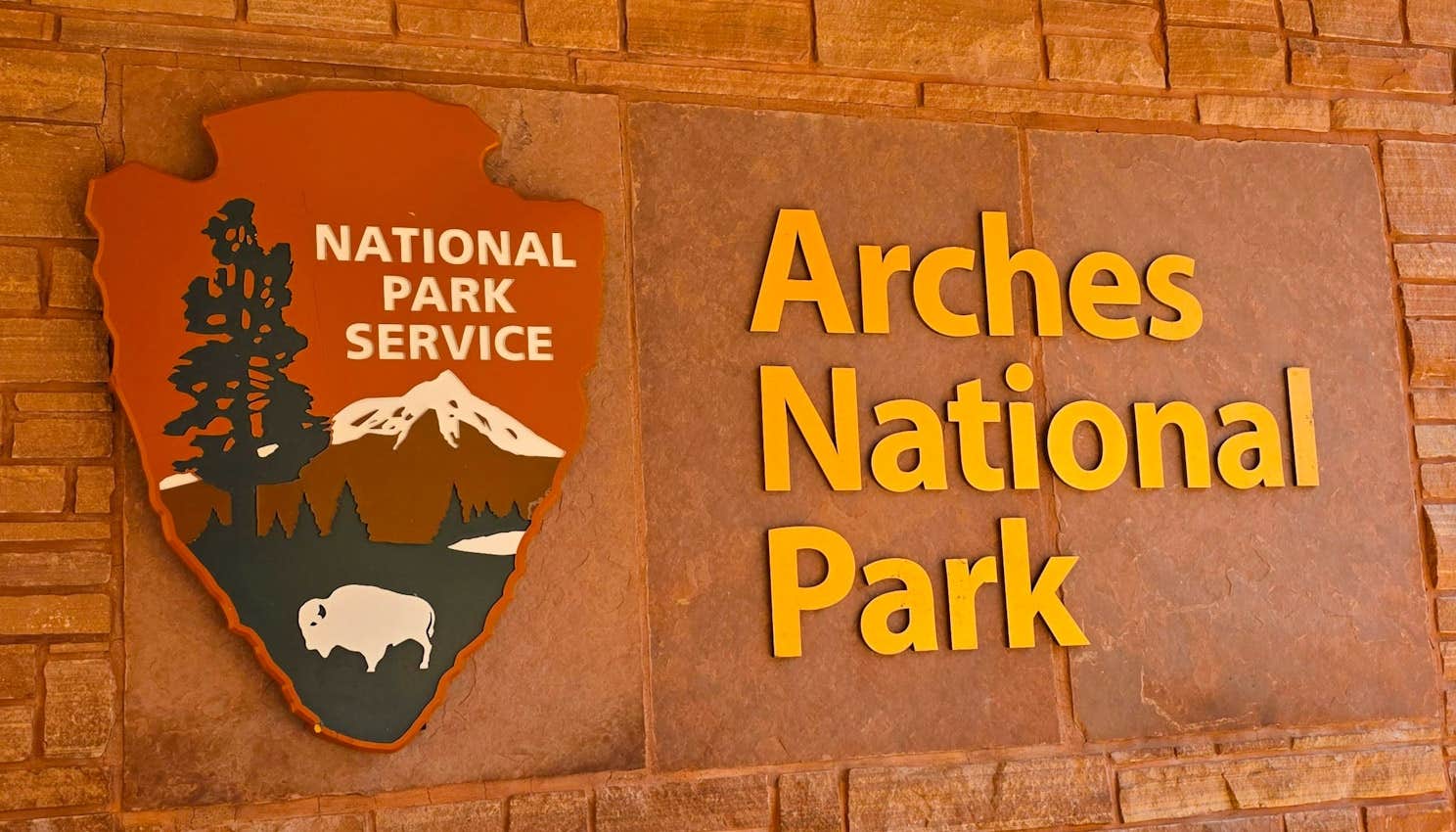Arches National Park Camping Guide
Arches National Park features Devils Garden Campground as its sole in-park camping option, plus plentiful camping near Arches National Park on BLM public lands and in private campgrounds around Moab. With iconic red rock formations and dark night skies, camping at Arches immerses you in Utah's high desert scenery. Devils Garden's 51 sites sit amid juniper and pinyon pines under towering sandstone fins deep in the park. Outside Arches, campers can choose from scenic riverside sites along the Colorado River, dispersed campsites around Arches National Park on public lands, or full-amenity RV camping near Arches National Park. This guide covers everything you need to plan and enjoy camping at Arches National Park, updated for 2025 with the latest reservation systems, seasonal tips, and insider advice.
Arches National Park Camping at a Glance
All campsites inside Arches are reservable during the peak season, with the Devils Garden Campground reservation window opening 6 months in advance (for stays March 1-October 31). During these busy months, Devils Garden is typically full every night. For 2025, a timed entry reservation is required to drive into Arches between 7am and 4pm from April 1-July 6 and Aug 28-Oct 31, although campers with a valid Devils Garden camping permit are exempt from the timed entry requirement. Nightly campsite fees start at $25 for individual sites (1-10 people). Two group sites are available ($75 for up to 16 people; $250 for up to 55 people). Most area campgrounds outside the park operate on a first-come, first-served basis, especially BLM sites near Arches National Park, so plan to arrive early in the day. Moab-area private campgrounds and the new Utahraptor State Park offer additional reservable options. Devils Garden sits at 5,200 feet elevation and is open year-round (first-come, first-served in winter). Summer days exceed 100°F, while winter nights drop below freezing, so pack accordingly for extreme desert temperatures.
Arches National Park Campground Quick Facts
| Quick Facts | Details |
|---|---|
| Number of Campgrounds | 1 campground inside Arches (Devils Garden) with 51 sites; numerous campgrounds in surrounding Moab area (BLM, state park, private) |
| Total Campsites | Devils Garden: 51 sites (including 2 group sites) BLM campgrounds along Colorado River: ~100 sites across multiple small campgrounds Dispersed camping: dozens of sites on BLM land north and west of Arches |
| Campsite Costs | In-park: $25/night for standard sites; $75-$250 for group sites BLM campgrounds: ~$20/night (cash, self-pay; first-come) Dispersed BLM: Free (no amenities) Private campgrounds: ~$40-$100/night (varies by facilities) |
| Reservation Platforms | Recreation.gov - Devils Garden Campground (6 months in advance) ReserveAmerica - Utahraptor State Park (4-month rolling window) Private campgrounds - individual websites or phone Timed Entry Tickets - Recreation.gov (for park entry, 6 months & daily release) |
| Camping Seasons | Devils Garden: Open year-round (reservations Mar-Oct; FCFS Nov-Feb) BLM campgrounds: Year-round (peak March-May & Sep-Oct) Utahraptor SP: Year-round (primitive, under development) Private campgrounds: Year-round (some may close in winter) |
| Temperature Ranges | Spring/Fall: Days 60-80°F, Nights 30-50°F Summer: Days 90-105°F, Nights 60-70°F (very low humidity) Winter: Days 30-50°F, Nights 0-20°F (occasional snow) |
| 2025 Updates | Timed-entry reservations required 7am-4pm Apr 1-Jul 6 & Aug 28-Oct 31 (campers with reservations exempt) New Utahraptor State Park offers additional primitive camping north of Arches Ongoing trail repairs may affect access to Fiery Furnace (check status) |
Arches Campgrounds: Complete Guide
In-Park Campground: Devils Garden
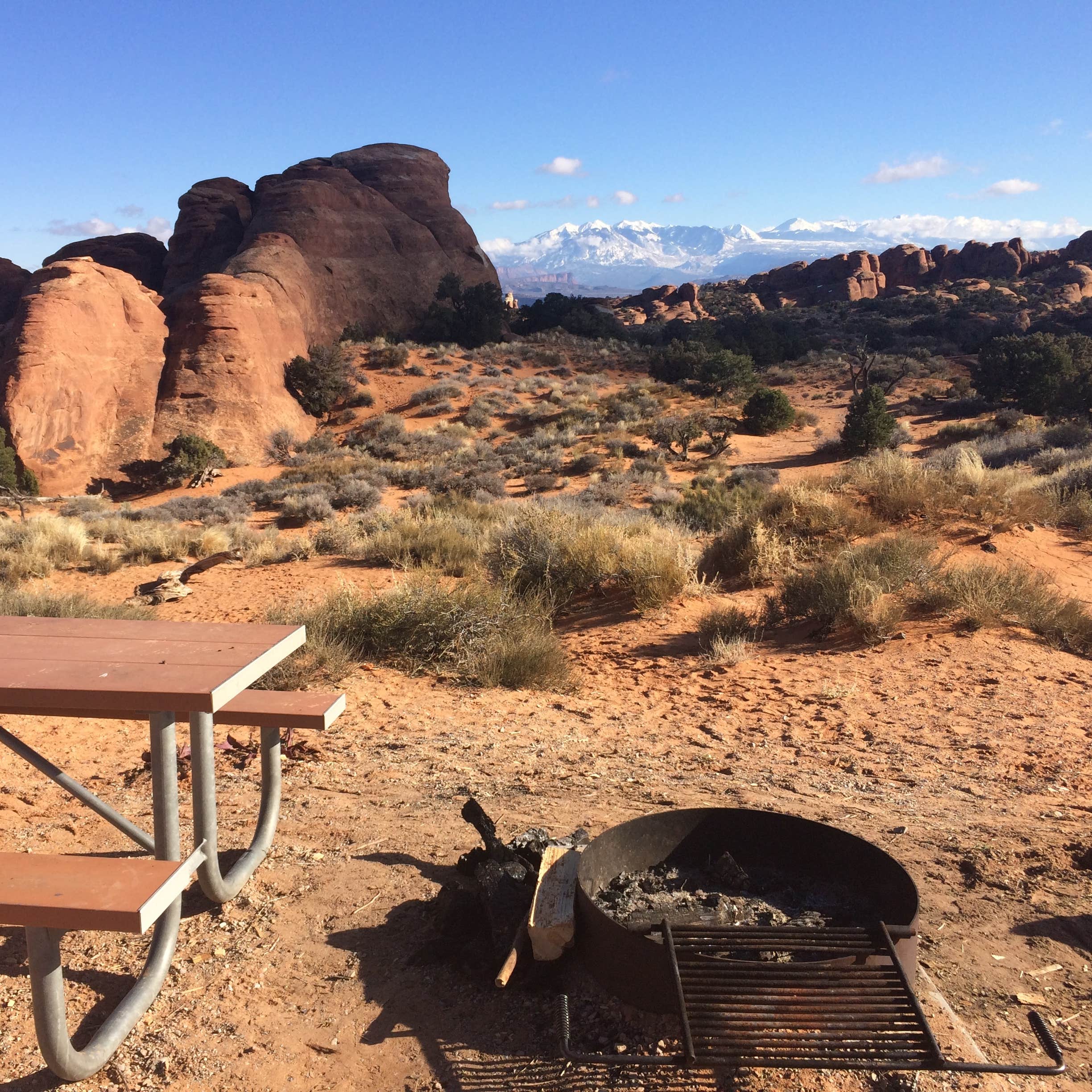
Devils Garden Campground — Arches National Park
Devils Garden Campground is Arches' only in-park campground, located 18 miles from the park entrance at road's end. Its 51 sites are set among slickrock outcrops, piñon pines, and junipers at 5,200 feet elevation. Each site has a picnic table and fire ring on a gravel or sandy pad. Flush toilets and drinking water are available (March-Oct), with vault toilets in winter. No RV hookups or dump station are provided (max RV length ~30 feet). The campground's dramatic setting offers direct access to the Devils Garden trailheads (Landscape Arch, etc.) and outstanding stargazing on clear nights. Reservations are required March through October (six months in advance via Recreation.gov), and the campground is typically full daily. From November through February, sites switch to first-come, first-served, making winter a quiet time to snag a spot. Expect hot days and cool nights in summer, and prepare for occasional thunderstorms or high winds year-round.
Campgrounds Near Arches National Park
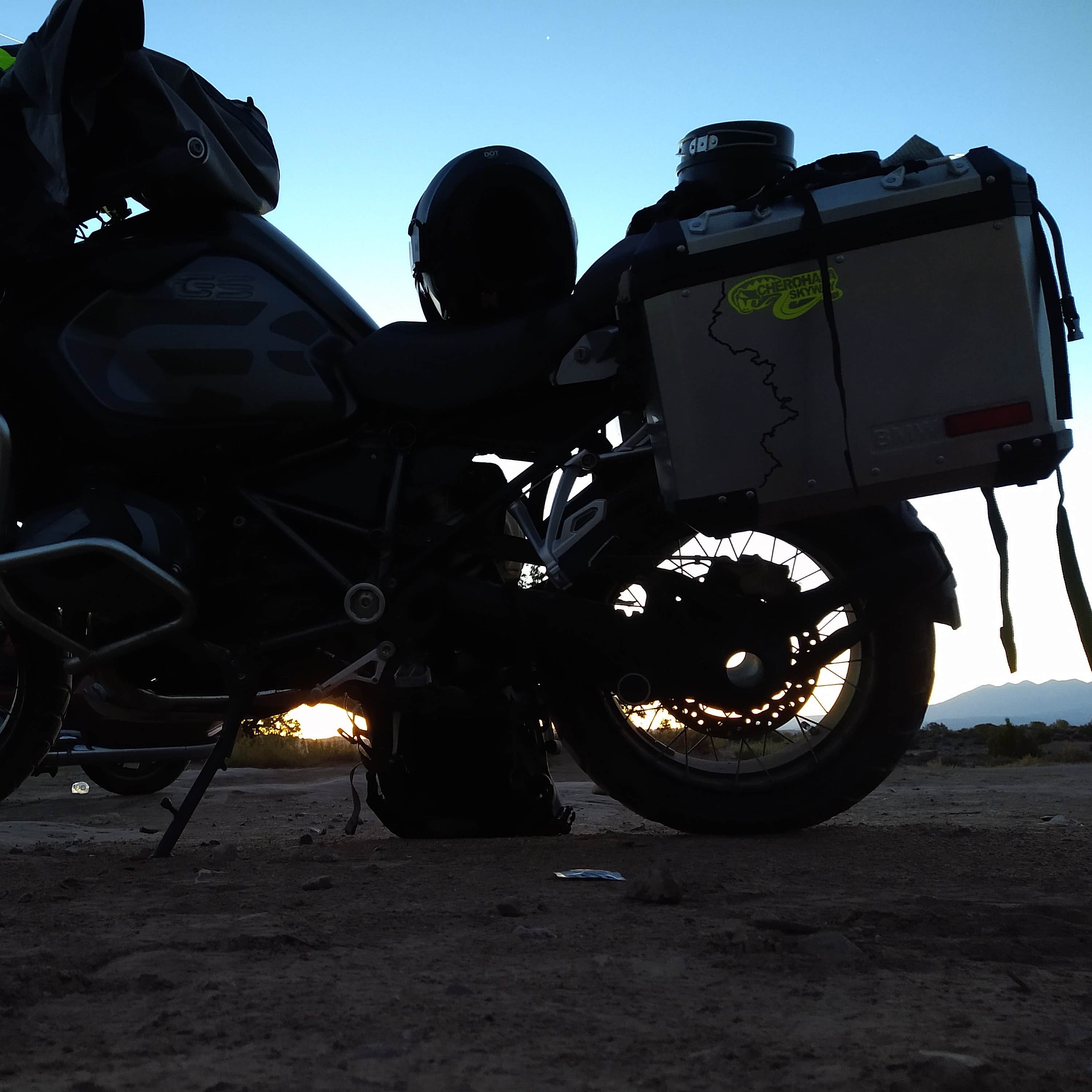
Utahraptor State Park Campground
Utahraptor State Park Campground - A new state park north of Arches (Dalton Wells/Willow Springs area) offering primitive camping amid slickrock and desert vistas. Currently in development, it provides dispersed sites (no designated pads yet) with a few porta-potties and no water or hookups. All sites are reservable on a 4-month rolling basis via ReserveAmerica (a $15 nightly fee per vehicle is charged). The camping area spans former BLM land near Willow Springs Road about 7 miles from Arches' entrance, giving easy access to Arches and Canyonlands' Island in the Sky district. Campers should be self-sufficient: bring water, fire pans, and pack out all waste. High-clearance vehicles are recommended on the rough roads. This area is known for its solitude and dark skies, with the trade-off of very limited amenities while the park infrastructure is under construction.
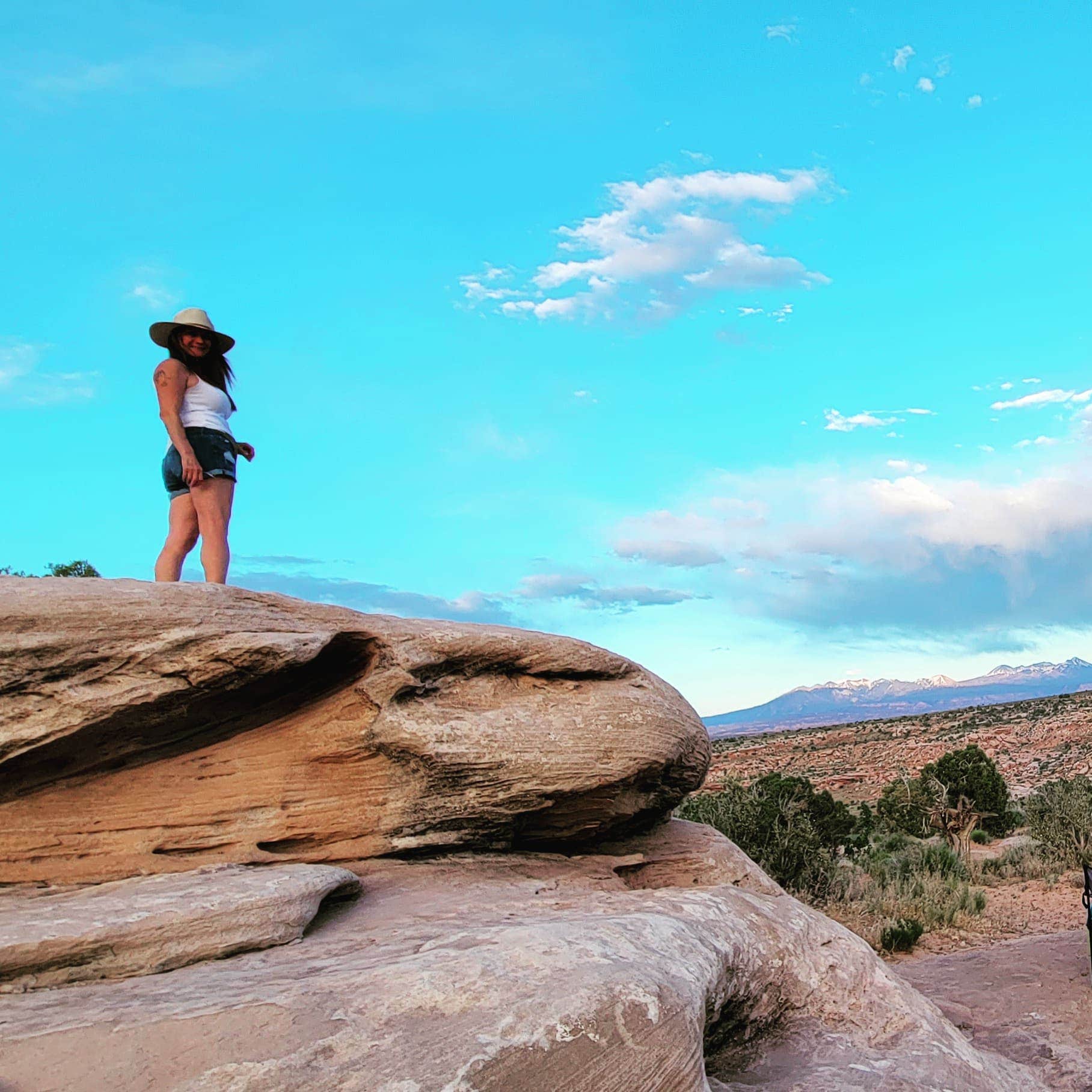
Willow Springs Trail
Willow Springs Road Dispersed Camping - A popular free camping zone on BLM land just outside Arches (accessed off US-191 about 7 miles north of the park). This area allows dispersed camping along dirt roads with no fees and no facilities (no toilets or water). Dozens of previously used sites exist, identifiable by cleared areas and fire rings. The terrain is open desert with views toward Arches' cliffs. A high-clearance vehicle is suggested as the road can be sandy or washboarded. Arrive early on busy weekends, as sites fill up by afternoon. Campers must pack out all trash and human waste (portable toilet or wag bags strongly encouraged). Despite the primitive setting, the location is extremely convenient—only a 10-15 minute drive to Arches Visitor Center—making it a favored overflow option when Devils Garden or other campgrounds are full. Expect dusty conditions and be prepared for wind, but you'll be treated to expansive night skies and sunrise over the red rocks.
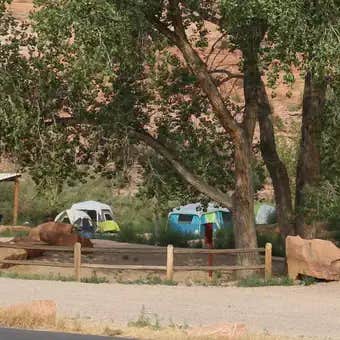
Goose Island Campground
Goose Island Campground (BLM) - A scenic 18-site campground along the Colorado River on Hwy 128, just 1.5 miles from Moab and ~4 miles from Arches. Campsites sit beneath cottonwood trees between the river and tall canyon walls, offering afternoon shade and river access. Amenities include picnic tables, fire grates, and vault toilets, but no potable water (bring your own). Sites accommodate tents and small RVs/trailers (no hookups). Goose Island is first-come, first-served and often fills by mid-morning in spring and fall. Its close proximity to Moab makes it popular for campers who want town conveniences while still enjoying a red-rock riverside setting. The sound of the flowing Colorado River and occasional sightings of bighorn sheep across the shore enhance the experience. Expect some highway noise due to the close road, but nights are generally peaceful under starry skies. Self-pay fees are about $20 per night; have exact cash ready.
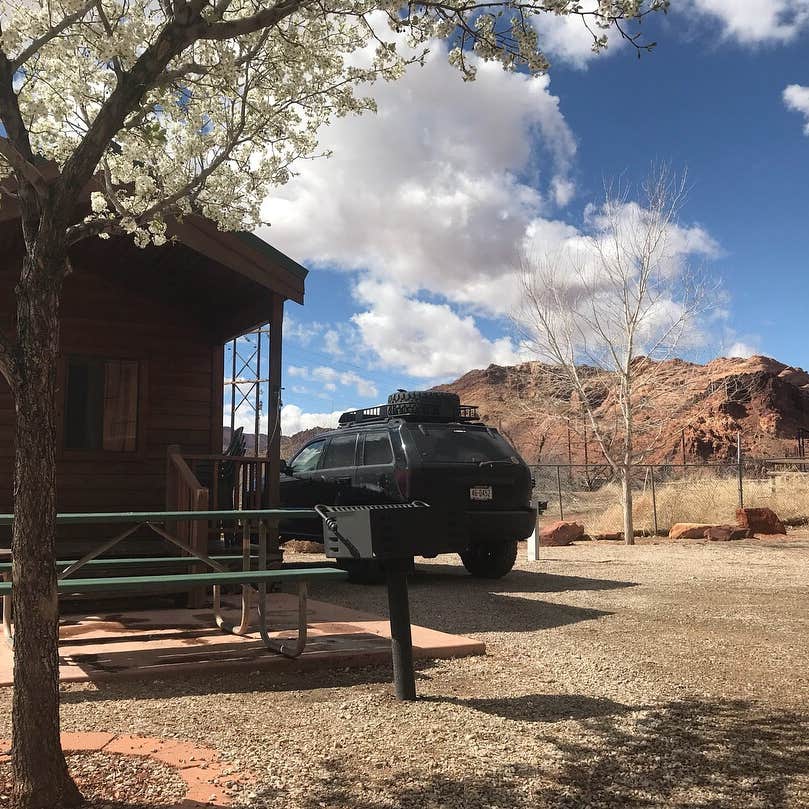
Sun Outdoors Arches Gateway
Sun Outdoors Arches Gateway (Private) - A full-service campground and RV resort located ~4 miles from Arches' entrance on Hwy 191, offering 100+ sites with a mix of pull-through RV sites (full hookups), tent sites, and cabin rentals. This modern campground (formerly Moab Valley RV Resort) provides extensive amenities: electrical/water/sewer hookups, hot showers, restrooms, laundry, Wi-Fi, a swimming pool, playground, camp store, and even mini-golf. Sites are gravel with shade trees; some tent sites have shelters. The atmosphere is family-friendly and social, with daily quiet hours enforced. While the surroundings are more developed (don't expect wilderness seclusion), the convenience is unbeatable - you can be inside Arches within 5-10 minutes of leaving your campsite. Reservations are recommended, especially for spring and fall when demand is highest. Nightly rates range from ~$60 for basic tent sites to $100+ for RV sites or cabins (varies by season). Pets are allowed, and the campground even has a dog park. This is an ideal base camp if you want comfort, easy park access, and proximity to Moab's restaurants and services.
Campground Comparison Table
| Campground | Location & Sites | Cost & Reservations |
|---|---|---|
| Devils Garden (in-park) | Inside Arches NP, 18 miles from entrance 51 sites (incl. 2 group) | $25/night (individual) Recreation.gov (Mar-Oct); FCFS Nov-Feb |
| Utahraptor State Park | 15 mi north of Arches (Dalton Wells area) Primitive dispersed sites (ongoing development) | $15/night per vehicle ReserveAmerica (4-mo rolling) |
| Willow Springs Road (BLM) | BLM land 8 mi north of Arches entrance Dozens of free dispersed campsites | $0 (free) First-come, first-served (no reservation) |
| Goose Island (BLM) | Along Colorado R. 2 mi from Moab (Hwy 128) 18 sites + 2 reservable group sites | $20/night (self-pay) First-come, first-served (groups via Recreation.gov) |
| Sun Outdoors Arches | Hwy 191, 4 mi south of Arches entrance 100+ sites (full-hookup RV, tent, cabins) | $66-$160/night (varies) Private - book via resort website/phone |
Arches Campground Amenities and Best Uses
In-Park (Devils Garden): This campground is best for campers who want immediate access to Arches' trails and viewpoints. You can roll out of your tent at dawn and be on the Devils Garden Trail before the crowds. Amenities include picnic tables, fire rings, and seasonal flush toilets/drinking water. There are no showers or hookups, so it's essentially dry camping with the benefit of a prime location. Because sites are relatively exposed (minimal privacy or shade), come prepared with sun shelters and be mindful of quiet hours - sound can travel in the open terrain. Devils Garden is ideal for stargazers, photographers, and hikers who value location over luxury.
Outside the Park (Moab Area): Campgrounds along the Colorado River (e.g. Goose Island) offer lush scenery and the sound of flowing water, making them great for tent camping near Arches National Park and small RVs who want a natural setting close to Moab. These BLM sites have basic facilities and no reservations, so they work best for flexible plans and early arrivers. Dispersed BLM camping areas like Willow Springs provide maximum privacy and zero cost - perfect for self-contained rigs or adventurous tent campers who don't need amenities. On the other end, private campgrounds (like Sun Outdoors Arches Gateway) are best for RV travelers, families, or those seeking full amenities - you'll get showers, power, and maybe a pool, in exchange for less solitude. Many visitors choose to stay in Moab-area campgrounds if Devils Garden is full or if they prefer a convenient base for exploring both Arches and other attractions (Canyonlands, Dead Horse Point). Consider your priorities: inside the park for immersion and night skies, or outside for easier town access and more facilities.
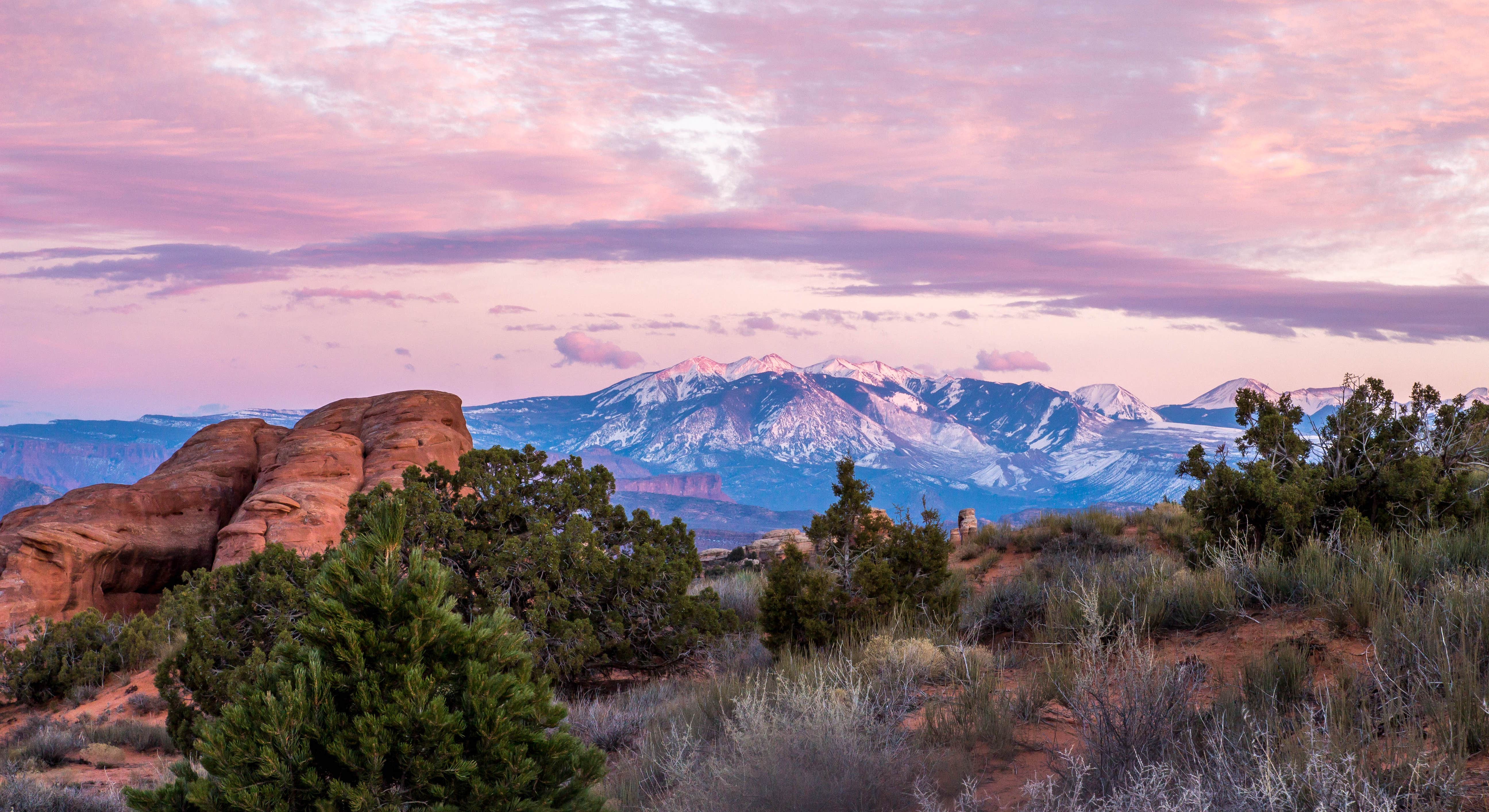 Photo by Darrin L
Photo by Darrin L
Planning Your Arches Camping Trip 
When to Visit Arches
| Season | Temperatures | Camping Conditions |
|---|---|---|
| Spring (March-May) | Day: 65-80 °F, Night: 35-50 °F | Ideal hiking weather; wildflowers bloom April-May Campground reservations essential (fills early) Windy periods possible - secure tents |
| Summer (June-August) | Day: 95-105 °F, Night: 65-75 °F | Extreme daytime heat - plan activities at dawn/dusk All campgrounds open; fewer crowds mid-summer Monsoon storms in July-Aug (lightning & flash flood risk) |
| Fall (September-October) | Day: 70-85 °F, Night: 40-55 °F | Warm days, cool nights - great for camping High demand returns (timed entry in place through Oct) Beautiful golden cottonwoods along Colorado River |
| Winter (November-February) | Day: 30-50 °F, Night: 0-25 °F | Cold, quiet season with possible snow dustings Devils Garden first-come, often many sites open Shorter days; bring cold-weather gear and prep for 0°F lows |
Spring (March-May):
Spring is one of the most popular times at Arches. Daytime highs in April hover around 70°F, making it comfortable for hiking to Delicate Arch or scrambling around The Windows. Nights can still be chilly (often in the 40s°F), so campers need warm sleeping bags. By mid-March, all park facilities are open and the campground is full nightly. Wildflowers like cactus blooms and primrose add pops of color to the red rock desert in April. Plan for crowds: trailhead parking lots fill early and timed entry tickets are in effect through spring. Wind is common in spring afternoons - secure your tent and stake down gear to avoid gusts sending items tumbling. Spring offers a balance of pleasant weather and lively park activity, with the trade-off of competition for campsites and permits (book early!).
Summer (June-August):
Camping in summer at Arches is a game of managing the heat. Expect intense sun and afternoon highs exceeding 100°F. Siesta strategy is key - many campers rise at sunrise to hike while it's "only" 75-80°F, then relax in shade or visit Moab during the scorching midday. Devils Garden Campground is fully open, but its juniper trees provide limited shade; bringing a canopy or sun tarp for your site is wise. Monsoon season peaks in late July and August, bringing sudden thunderstorms that can cool things briefly but also cause flash floods in washes. Ensure your tent's rainfly is ready and pitched even on clear mornings - storms can develop fast. Nights remain warm (upper 60s°F) which makes for comfortable tent sleeping, and the upside of summer is brilliant night skies and milky way viewing (the park often runs astronomy ranger programs). Crowds are actually slightly lower in the peak of summer compared to spring/fall because of the heat, so spontaneous first-come sites at nearby BLM campgrounds might be easier to snag. If you can handle the heat, summer camping at Arches means longer daylight hours and full access to ranger programs and tours.
Fall (September-October):
Fall brings campers back to Arches in droves - and for good reason. September still feels like summer early in the month (80s°F days), then gradually cools to perfect hiking weather in October (70°F days, crisp 40°F nights). This season sees clear, stable weather more often than spring, with less wind. Cottonwood trees along Courthouse Wash and the Colorado River turn golden by mid-October, adding color to the scenery. The Devils Garden Campground remains on reservation system through October 31, and demand is high, especially around holidays like Labor Day or Utah's October school break. Evening campfires become more popular again as nights dip into the 40s - be sure to check for any fire restrictions (early fall can still be dry). By late October, the timed entry pilot ends and crowds taper off, making the first week of November a hidden gem for quieter camping. Fall offers the best of both worlds: summer-like scenery and access, with more comfortable temperatures and gradually thinning crowds after mid-October.
Winter (November-February):
For hardy campers, winter at Arches is a time of serenity and solitude. Daytime highs in the 40s°F allow for pleasant hiking (especially with a sun's warmth), but once the sun sets, temperatures plummet quickly - nights in the teens or single digits are common. The campground switches to first-come, first-served and often has many vacancies, so you can arrive without a reservation. Key facilities (visitor center, flush toilets, potable water) are limited in winter: the campground's water may be shut off to prevent pipe freeze (bring water or fill up in Moab). Snowfall is sporadic - a light snow can blanket the red rocks, creating stunning scenes and very slick trails. Be prepared with warm layers, a zero-degree rated sleeping bag, and a four-season tent or extra tarp to break the wind. Though cold, winter camping rewards visitors with absolute quiet in the park, no timed entry restrictions, and brilliant stars during the long nights. Keep in mind the short daylight (sunset by 5pm in December) - you'll be spending extended time in camp after dark, so bring books, games, or plan for a toasty campfire (firewood must be brought in). If you dream of having Delicate Arch to yourself at sunrise, a winter camp trip might make it possible.
Arches Reservation Systems Explained
Planning a camping trip at Arches requires navigating a couple of reservation systems: one for camping and one for park entry during peak hours. Here's what you need to know:
Devils Garden Campground (Recreation.gov): All individual sites in Devils Garden are reservable on Recreation.gov up to 6 months in advance. Reservations open daily for dates six months out (e.g. on January 1, slots open for July 1). Mark your calendar and be ready at 8:00 AM Mountain Time when the booking window opens - sites can fill within minutes for spring and fall dates. Create or log into your Recreation.gov account beforehand for a smooth checkout. You'll need to pay the first night's $25 fee when booking. If you don't initially snag a site, keep checking back: cancellations do occur, especially 1-2 weeks prior as plans change. From March through October, you must have a reservation to camp inside the park (no walk-ups). In the off-season (Nov-Feb), no reservations are accepted - simply arrive and self-register for any open site (pay at the kiosk or via the Scan & Pay app). Note that even in winter, the campground can fill on holiday weekends. There is a 7-day per month, 14-day annual limit per group in the campground, so plan accordingly if you intend an extended stay. If you have a Devils Garden reservation, that confirmation doubles as your entry ticket into the park - you do not need a separate timed entry ticket (just show your campground reservation at the gate).
Timed Entry Tickets (Recreation.gov): In 2025, Arches continues its pilot Timed Entry system to manage peak visitation. If you plan to enter the park between 7:00 AM and 4:00 PM from April 1 through July 6 or August 28 through October 31, you'll need to reserve an entry timeslot on Recreation.gov. These $2 tickets are vehicle-specific and do not include the campground - they're only for park entry. The initial block of tickets releases 6 months in advance (for the entire month in one batch, e.g. on January 2 at 8am MT, tickets for all of April open). Subsequent monthly blocks open on the 1st of each month for later-season dates. Additionally, a set of "next-day" tickets becomes available at 7:00 PM MT each evening for entry on the following day (great for more spontaneous trips). If you have a camping reservation, Fiery Furnace tour, backcountry permit, or other in-park permit, you are exempt from needing a timed entry ticket - just show proof at the entrance. But for everyone else, these reservations are effectively required to enter during busy hours. Timed entry tickets must be reserved online in advance and often "sell out" quickly for popular spring dates, so treat it similar to snagging a campsite: be online right when they open. Print or download your QR-coded entry ticket before arriving (cell service at the gate is hit or miss). Each timed entry lets you enter during a one-hour window (for example, a 10am ticket means you can arrive between 10:00 and 10:59). Once you're inside, you can stay all day and exit/re-enter freely after 4pm. If you miss getting a ticket, your alternatives are entering before 7am or after 4pm (no ticket needed then), or trying for the 7pm nightly release for next-day spots. Remember you also need to pay the normal park entrance fee or show a parks pass at the gate in addition to the timed reservation.
In summary, make campground reservations early for peak season, and secure timed entry tickets if visiting in spring or fall daylight hours. Recreation.gov handles both, so familiarize yourself with its system ahead of time. For reservable camping outside the park, check each site's platform: for instance, BLM's new Utahraptor State Park uses ReserveAmerica, while private Moab campgrounds each have their own websites. With a bit of planning and timing, you can lock in your campsite and entry pass for a stress-free adventure.
Campground Costs and Budgeting
| Campground Type | Nightly Cost | Key Features |
|---|---|---|
| National Park Campground | $25 (standard site) $75-$250 (group sites) | Devils Garden - flush toilets, water (in season), no hookups Scenic location in park; reservation fee $8 on Recreation.gov |
| BLM Developed Campground | $15-$20 (exact change self-pay) | Examples: Goose Island, Grandstaff Vault toilets, picnic tables, no water or hookups First-come, first-served; cash or check required |
| BLM Dispersed Camping | $0 (free) | No amenities - pack out all trash & waste Areas like Willow Springs, Klondike Bluffs No permit needed, but 14-day stay limit |
| Utahraptor State Park | $15 per night (per vehicle) | Primitive sites, currently no facilities Fees via ReserveAmerica or self-pay app Supports new state park development |
| Private Campground/RV Park | $50-$100+ (varies by site type) | Examples: Sun Outdoors, Moab KOA Full hookups, showers, pool, Wi-Fi often included Online or phone reservations; often credit card deposit |
Additional Fees and Budget Tips
Park and Entry Fees: The $30 vehicle entry fee is valid for 7 days - if you're combining Arches with Canyonlands or other parks, consider the $80 America the Beautiful annual pass. Timed entry tickets (if needed) are $2 on Recreation.gov; if you reserve a campsite, you can skip this extra fee by using your camp reservation for entry.
Facility and Service Fees: Firewood costs $8-10 per bundle at campground stores or in Moab. Ice costs $3-5 per bag at general stores. Showers are not available in the park; consider paying for a shower in Moab if needed. The Moab Recreation & Aquatic Center offers hot showers for a few dollars, or some private campgrounds may let non-guests shower for a fee.
Camping Gear Rentals: Don't own gear? Moab has outfitters that rent tents, sleeping bags, and camp stoves. Expect ~$20-$40 per day for a basic tent/sleep kit rental. This can be useful for fly-in visitors. Reserve gear ahead during peak season to ensure availability.
Budget-Friendly Alternatives: National Forest Campgrounds cost $8-20 per night just outside park boundaries. Dispersed camping around Arches is free in surrounding BLM areas. Low season visits in spring and fall offer better availability. Canyonlands dispersed camping also provides nearby free options for those exploring multiple parks.
Essential Gear for Arches Camping
The high desert environment of Arches demands careful packing. Summers are scorching and dry, while nights (even in July) can feel cool once the desert heat dissipates. And unlike mountain or forest camps, you won't find abundant shade or water on site. Prepare for sun, heat, and rugged terrain. Here's a gear checklist to ensure you're comfortable and safe:
Shelter and Sleep:
- Three-season tent with full rainfly - A sturdy tent that can handle strong canyon winds is important. Stake it well; spring winds or summer gusts from thunderstorms can uproot flimsy shelters.
- Sun shade or canopy - Since shade is limited, a pop-up canopy or reflective tarp over your picnic table can create a vital oasis of midday relief.
- Sleeping bag and liners - In summer, a lightweight bag (rated ~40°F) is fine (you might even just use a sheet on very hot nights). For spring/fall, bring a warmer bag (20-30°F). In winter, a 0°F bag plus an insulated sleeping pad is required.
- Ground tarp/footprint - The ground is rocky and can be abrasive. Using a footprint under your tent protects it and also as a surface to sit or lie on under the stars.
Kitchen and Water:
- Large water containers - Carry at least 1-2 gallons per person per day. Hydration is critical; consider a 5-gallon jug in camp for cooking and cleaning, plus water bottles or a hydration bladder for hikes. Water is available at Devils Garden (seasonally) and visitor center, but not at BLM sites.
- Cooler with ice - A high-quality cooler will keep food fresh longer in the desert heat. Block ice or dry ice lasts longer than cubes. Keep the cooler in shade or covered.
- Camp stove and fuel - Fire restrictions can limit campfires, so a propane or white gas stove ensures you can still cook. Two-burner stoves are great for group cooking; small backpacking stoves suffice for simple meals.
- Food storage - While Arches doesn't have bears, ravens, chipmunks, and mice are expert food thieves. Use latching coolers or secure bins for all food and trash.
- Biodegradable soap & washtub - If washing dishes, use a tub and strain food scraps (pack them out, don't dump). Gray water should be poured into campground drains if provided, or broadcast over a wide area away from camp in dispersed sites.
Sun and Clothing:
- Sun protection essentials - This is critical. Pack a broad-brimmed hat, UV-blocking sunglasses, and plenty of high-SPF sunscreen (and lip balm with SPF). Reapply often; the sun at Arches (especially reflecting off red rock) is intense even on cooler days.
- Lightweight long-sleeve shirts and pants - To avoid sunburn and stay cooler than in direct sun on skin, many desert campers wear long-sleeve breathable shirts and convertible or lightweight hiking pants. Fabric that offers UPF protection is a plus.
- Ventilated hiking boots or trail shoes - You'll be scrambling on slick rock and uneven trails. Sturdy footwear with good traction is a must. In summer, some prefer breathable trail runners; just mind the sand getting in.
- Warm layers for night - No matter how hot the day, bring a fleece or insulated jacket for evening. Once the sun goes down, temperatures can drop rapidly (a 100°F day might become a 60°F night).
Camping Essentials:
- Headlamp and extra batteries - Navigate the campground or trails in the dark (helpful for pre-dawn hikes to Delicate Arch). A headlamp keeps your hands free and red light mode can preserve night vision.
- First Aid Kit - Include basics plus desert-specific items: tweezers for cactus spines, plenty of adhesive bandages (rock scrapes happen), blister care (moleskin, as sandy hikes can rub feet), and allergy meds.
- Daypack and hydration system - You'll be doing day hikes. A comfortable backpack with a 2-3 liter hydration bladder or bottles is important.
- Camp table and chairs - Devils Garden sites have picnic tables, but many BLM sites do not. A collapsible camp table and camp chairs make meal times and lounging under the stars much more comfortable.
- Navigation and backup comms - Download offline maps of the area (Arches maps, Moab trails) on your phone or bring a paper map. Cell service is spotty-to-none in the campground and many parts of the park.
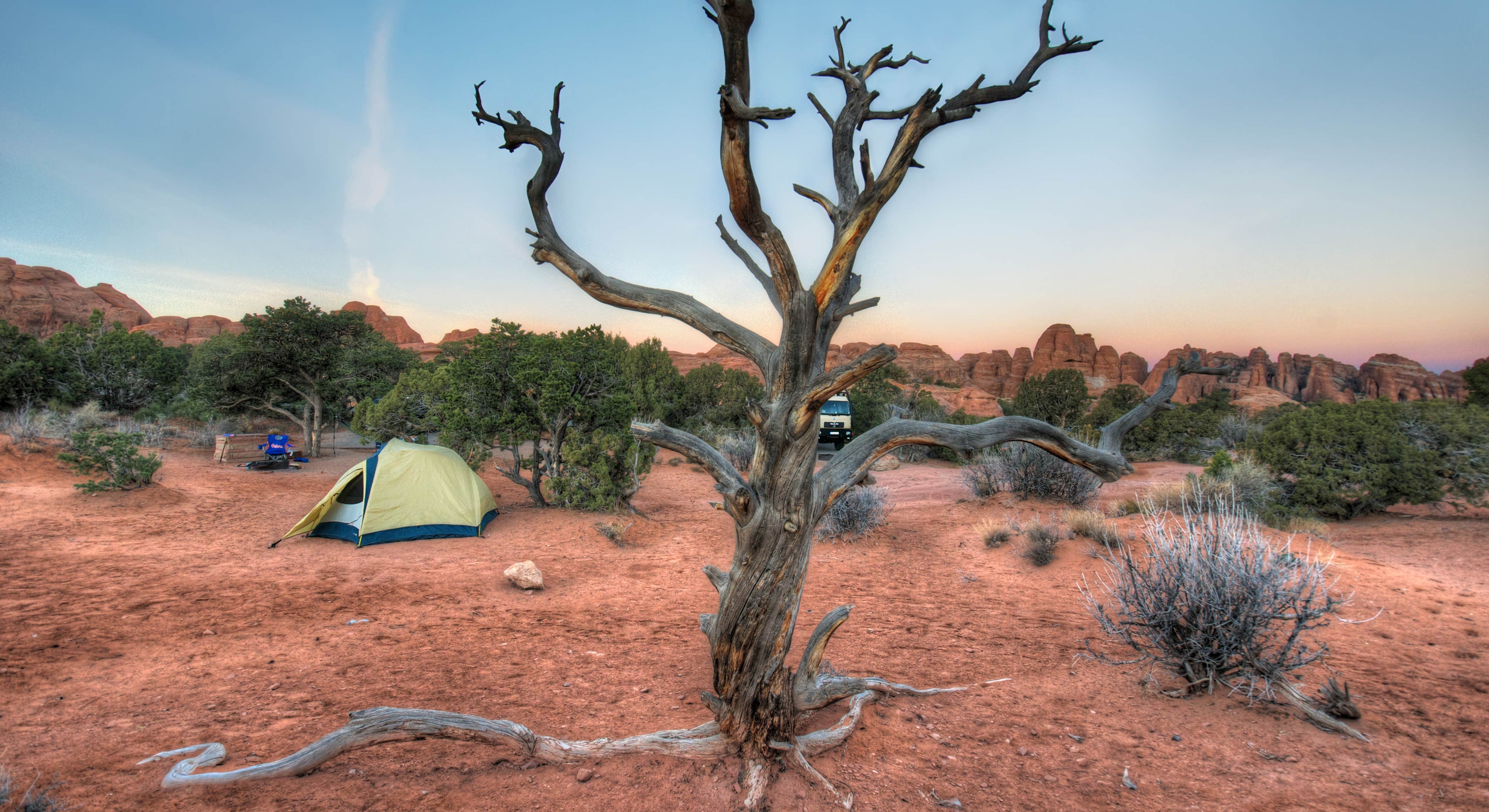 Photo by Asher K
Photo by Asher K
Wildlife Safety and Park Regulations 
Desert Wildlife Awareness
Arches lacks some of the large dangerous animals seen in other parks (there are no bears here), but there are still important wildlife considerations and rules to follow to protect both animals and visitors. Additionally, Arches and the surrounding lands have regulations in place to preserve the fragile desert ecosystem and ensure a pleasant experience for everyone.
Snakes and Scorpions: Arches is home to rattlesnakes (primarily the midget faded rattlesnake) and various scorpions. These critters are rarely aggressive but will defend themselves if provoked. Always watch where you step or reach when scrambling on rocks or gathering firewood. Shake out your boots, clothes, and sleeping bags in the morning - scorpions or other insects might seek shelter overnight. Use a flashlight or headlamp at night to avoid stepping on anything. If you encounter a rattlesnake (you may hear its buzz first), give it plenty of space to retreat. Teach children not to pick up rocks or reach into crevices blindly.
Ravens and Rodents: The common raven is the unofficial campground thief at Arches. Highly intelligent and bold, ravens have been known to unzip tents, unlatch coolers, and steal anything from food to shiny objects. Never leave food unattended on picnic tables - a raven can swoop in the moment your back is turned. Store all food in secure containers or your vehicle when not actively using it. Similarly, pack up garbage promptly (ravens will tear into plastic trash bags). Smaller rodents (rock squirrels, mice) are also on the lookout for crumbs.
Keep Your Distance: While Arches doesn't have large mammals like bison or elk, it does have some wildlife worth viewing from afar. You might spot desert bighorn sheep on cliffs or mule deer in the washes at dawn/dusk. The rule of thumb is to give any wildlife at least 50 feet of space. Never feed wild animals - it's unhealthy for them and illegal.
Park Regulations and Etiquette
| Regulation Category | Specific Rules | Penalties |
|---|---|---|
| Campfires | Allowed only in provided fire rings/grates No collecting firewood (bring your own) Must be fully extinguished with water before leaving or sleeping | Rangers may issue fines for unattended or improper fires Fire bans in effect during high fire danger - propane stoves only at those times |
| Quiet Hours | Typically 10:00 PM - 6:00 AM in campgrounds Generator use permitted 8:00 AM - 8:00 PM only (Devils Garden allows generators in select sites) | Verbal warnings for noise first Persistent violations can result in eviction from campground |
| Pets | Must be on leash (max 6 ft) at all times Not allowed on any hiking trails or in the backcountry Never leave pets unattended (desert heat can be fatal) | $50+ fines for off-leash or on-trail violations Pets in closed areas may also trigger removal from park |
| Protecting Resources | Do not walk on or disturb cryptobiotic soil (the black crusts) Stay on trails - creating new paths harms fragile plants No graffiti or collecting rocks, plants, artifacts | Damaging biocrust or defacing rocks can incur heavy fines Vandalism or artifact theft may result in federal charges |
Waste Disposal: Arches requires that you pack out all trash - "pack it in, pack it out" is strictly enforced. Trash cans and dumpsters are available at Devils Garden and trailheads; use them rather than leaving any litter in camp. For dish water at Devils Garden, pour into the designated utility drain near the restroom (do not dump on soil). If you're dispersed camping, strain food bits from dishwater and scatter the water at least 200 feet away from any camp or water source. Human waste in the backcountry or dispersed sites must be buried 6-8 inches deep (and pack out toilet paper).
Fire Restrictions: Always check current fire rules. In dry summer periods, the park and BLM often implement Stage I fire restrictions (meaning campfires allowed only in provided rings, no open fires in dispersed sites) or Stage II (no open flames at all, even in rings). These will be posted on bulletin boards and online. Violating fire bans is taken seriously due to wildfire risk. If fires are allowed, keep them small - only use dead and down wood (outside the park, since you can't collect inside Arches) or purchased firewood.
Backcountry Camping: Arches has extremely limited backpacking opportunities (a few designated zones, requiring a free backcountry permit from the visitor center). If you venture out, follow Leave No Trace strictly - no campfires in the backcountry, camp on rock or bare ground, and travel on durable surfaces to avoid crushing cryptobiotic soil.
Beyond the Campground: Activities and Exploration 
Day Trips from Arches Campgrounds
From Devils Garden Campground: Being at the end of the park road has its perks - you're steps away from trailheads. A highly recommended half-day hike is the Devils Garden Loop, which starts right in the campground and visits Landscape Arch (the park's longest span) and other arches like Navajo and Partition; do the full primitive loop (7.2 miles) for a bit of rock scrambling and fewer people. Early morning is magical on this trail. For a shorter excursion, hike Skyline Arch Trail, just 0.4 miles round-trip from a pullout 5 minutes drive from camp - many campers do this at sunset when the arch glows. After hiking, consider a scenic drive: from camp, it's about 30 minutes to Windows Section, where you can do a leisurely stroll among multiple arches (North & South Window, Turret Arch) and have a picnic with a view.
From Moab Area Campgrounds: Staying along the Colorado River or in Moab gives you versatility to explore multiple destinations. A top recommendation is a day trip to Dead Horse Point State Park and Canyonlands (Island in the Sky) - from Moab, drive 45 minutes to Dead Horse Point for a view 2,000 feet above the Colorado, then continue 15 minutes to Canyonlands' mesa-top overlooks. If you camp at Goose Island or along Hwy 128, you can start your day with a calm Colorado River float - local outfitters offer half-day rafting trips that often depart mornings. In the afternoon, explore SR-128's sights: from Goose Island, it's 4 miles to Grandstaff Canyon Trail (morning hike to a hidden natural bridge) or a bit further to Castle Valley's winery for a tasting.
Top Hiking Trails Near Campgrounds
| Trail Name | Difficulty & Distance | Key Features |
|---|---|---|
| Devils Garden Loop (including Primitive Trail) | Moderate/Strenuous 7.2 miles round-trip (loop) | Starts at Devils Garden Campground; 7+ arches including Landscape Arch, Double O Arch Rock scrambling on primitive section, fewer crowds past Landscape Arch |
| Delicate Arch Trail | Moderate 3 miles round-trip | Iconic arch perched on a bowl - must-see at sunrise or sunset Steep slickrock ascent and no shade; trailhead at Wolfe Ranch (12 miles from campground) |
| The Windows & Double Arch | Easy 1.2 miles (Windows Loop) + 0.5 miles (Double Arch) | Family-friendly stroll to multiple big arches in one area Gentle paths with grand views; short scramble inside Double Arch's cavernous openings |
| Park Avenue Trail | Easy/Moderate 2 miles round-trip (or 1 mile one-way) | Sandstone "skyscrapers" line this canyon walk near park entrance Great introductory hike, can be done as one-way if shuttle between trailheads |
| Fiery Furnace (permit required) | Strenuous ~2 miles (loop or out-and-back routes vary) | Maze-like fins and slot canyons - a challenging route-find adventure Must obtain permit or go on ranger-led tour; no marked trail, requires agility and navigation |
Trail Access and Starting Points
From Devils Garden Area: The Devils Garden Trailhead is located within the campground, making it effortless to beat the crowds to popular spots like Landscape Arch in the morning. Hikers from outside the park have to drive 45 minutes from the entrance - you're already there. For Delicate Arch, drive ~20 minutes from camp to Wolfe Ranch Trailhead (consider leaving before dawn to catch sunrise at the arch - the trail will be cooler and far less crowded). Another short drive (5 miles, 10 min) gets you to Sand Dune Arch/Broken Arch loop trail - a fun, family-friendly excursion through sandy fins.
From Moab (North) Campgrounds: If you're camping along US-191 north of Moab (Sun Outdoors, Moab North, etc.), you're roughly 10 minutes from Arches' gate. This makes it easy to do early or late hikes without a long commute. You can be at Park Avenue trailhead or Courthouse Towers Viewpoint in about 15 minutes for a quick hike or scenic viewpoint.
From Highway 128 (River) Campgrounds: Those at Goose Island, Grandstaff, or along the river road have a scenic 8-12 mile drive into Arches via the Moab town route. It's typically ~20 minutes to the visitor center. One advantage: you can easily combine a morning hike in Arches (say, Windows Section), then around mid-day slip back out to your river camp for a cooling dip or rest, and later do an evening hike along the river.
Water Activities in Arches
While Arches National Park itself is a desert with no rivers or lakes inside the park boundaries, the nearby Colorado River and other water features around Moab offer refreshing ways to cool off and have fun.
River Rafting and Floating: The Colorado River carves a scenic path just outside Arches, and it's the focal point for local water recreation. A popular section for visitors is the Moab Daily - a stretch of the Colorado running from just above Arches (Hittle Bottom area) down to points near Moab. This is generally a Class I-II section (gentle rapids), perfect for half-day rafting trips or a mellow kayaking excursion. Numerous outfitters in Moab offer guided rafting floats; they'll provide life jackets, gear, and shuttles. If you have your own equipment, you can do a self-guided float. Always check conditions and flow rates; in spring, snowmelt makes the river faster and colder.
Swimming and Wading: There are no designated swimming spots inside Arches, but along the Colorado River there are a few areas where people wade or take a quick dip. One such spot is near Big Bend Campground (on Hwy 128): it has a small sandy beach and usually a calm eddy along the shore where you can wade knee-deep. Keep in mind the Colorado is a big river - it's cold (rarely above 60°F even in summer) and can have swift currents. Do not swim in stretches of river with strong current or unknown depths. There are no lifeguards.
Safety Guidelines for Water Recreation: When rafting, kayaking, or even just floating on inner tubes, always wear a properly fitted personal flotation device. Even strong swimmers can be overwhelmed by currents or surprise rapids. Avoid alcohol during water activities. Be cautious of flash floods: slot canyons and washes in Arches can flood suddenly from distant rain.
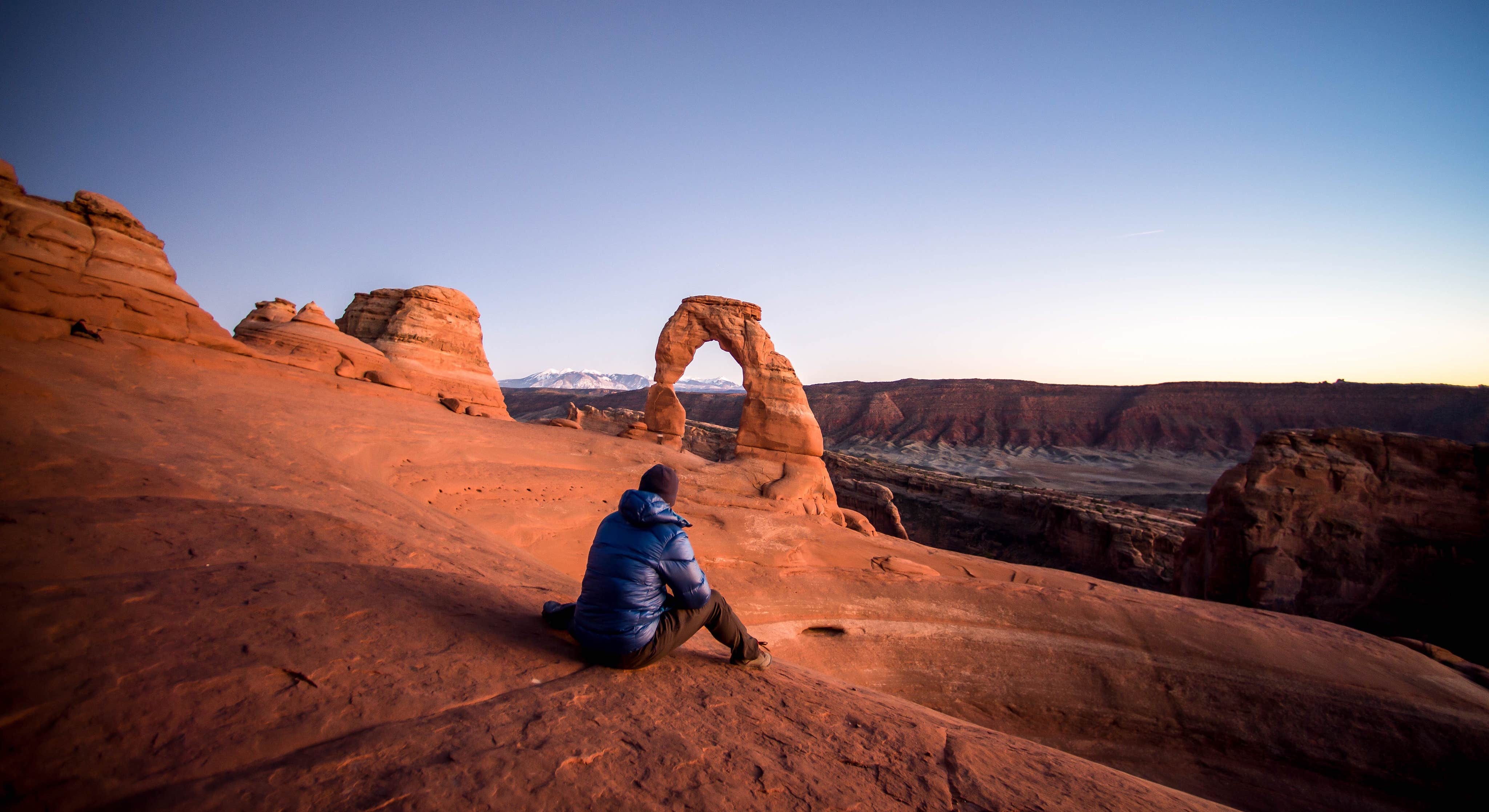 Photo by Red John M
Photo by Red John M
The Dyrt Community Insights 
Ranger Recommendations
The Dyrt Rangers (experienced reviewers) share these insider pointers from their Arches adventures:
Devils Garden - Best Sites: "Try to reserve sites in the outer loop for more space and epic views," suggests one Dyrt Ranger who frequents Arches. In Devils Garden Campground, sites #21, #22, and #24 are near a high point ("the summit") with fewer obstructions - you get incredible 360° vistas of sandstone fins and distant La Sal Mountains. Meanwhile, sites like #46, #48, and #52 back up against rock formations, tucking you into the scenery and offering a bit more privacy from neighbors. All sites are good, but these specific ones come up repeatedly in reviews as favorites.
Beating the Summer Heat: One seasoned Arches camper shares this strategy: "I plan my hiking for first light and my sightseeing for evening; midday, I find shade - even if it means driving into Moab for a long lunch." Rangers concur that summer visitors should avoid strenuous activity between 11am and 4pm. Use that window for a siesta: read under a picnic shelter, dip your bandana in ice water, or even take the short drive to Matrimony Spring in Moab to refill jugs with cold spring water.
Free Camping Tips: Many Dyrt users love the freedom of dispersed camping on BLM land around Arches. A Ranger familiar with the area notes, "Willow Springs (BLM) is an awesome free camping area, but arrive early - it fills up, especially on weekends. And have a Plan B." Plan B could be other BLM spots like Klondike Bluffs or Cotter Mine Road if Willow Springs is packed. The Ranger also emphasizes Leave No Trace: "No one is coming to clean up out there. Pack out all trash, and bury human waste deep or use wag bags - don't turn a beautiful free campsite into a toilet."
Top-Rated Sites from The Dyrt Community
| Category | Top Pick & Rating | Key Highlights |
|---|---|---|
| Highest-Rated In-Park | Devils Garden Campground 4.7/5 | Unbeatable location among arches, dark sky stargazing, well-maintained facilities (water & toilets) |
| Best Free Dispersed | Willow Springs Road (BLM) 4.6/5 | Cost $0, expansive views, close to Arches entrance, can accommodate RVs and tents (rough road in spots) |
| Scenic BLM Campground | Goose Island Campground 4.5/5 | Shady riverfront sites, canyon wall sunsets, convenient to Moab and Arches (no reservations, fills early) |
| Private Campground Experience | Sun Outdoors Arches Gateway 4.5/5 | Resort-style amenities, great for families (pool, Wi-Fi), minutes from park, some highway noise but secure and clean |
Community Insights and Recommendations
Starry Skies Galore: Campers consistently mention the incredible night skies around Arches. Even when staying at the more developed Moab campgrounds, many folks drove into Arches or along Hwy 128 at night to stargaze. The consensus: bring a star chart or an app, and if possible, plan one moonless night for your trip - the Milky Way views in summer are astounding. Devils Garden campground, being 18 miles from town lights, offers one of the darkest skies.
Expect Wind and Secure Your Gear: Multiple reviews across The Dyrt warn about wind, especially in spring or during distant thunderstorms. "We returned from a sunset hike to find our tent upside down in the junipers - stake it like you mean it!" wrote one camper. It's a common refrain: use guy lines on your tent, store camp chairs and light items in your car when you leave camp, and weigh down that tablecloth.
Day Trip to Needles or La Sal Mountains: Some Arches campers suggested fantastic side trips if you have an extra day. One is to drive to the Needles District of Canyonlands (about 1.5 hours one-way from Moab) - it's a long day but doable, and quite different from Island in the Sky. Another is to escape the heat by heading up into the La Sal Mountains southeast of Moab.
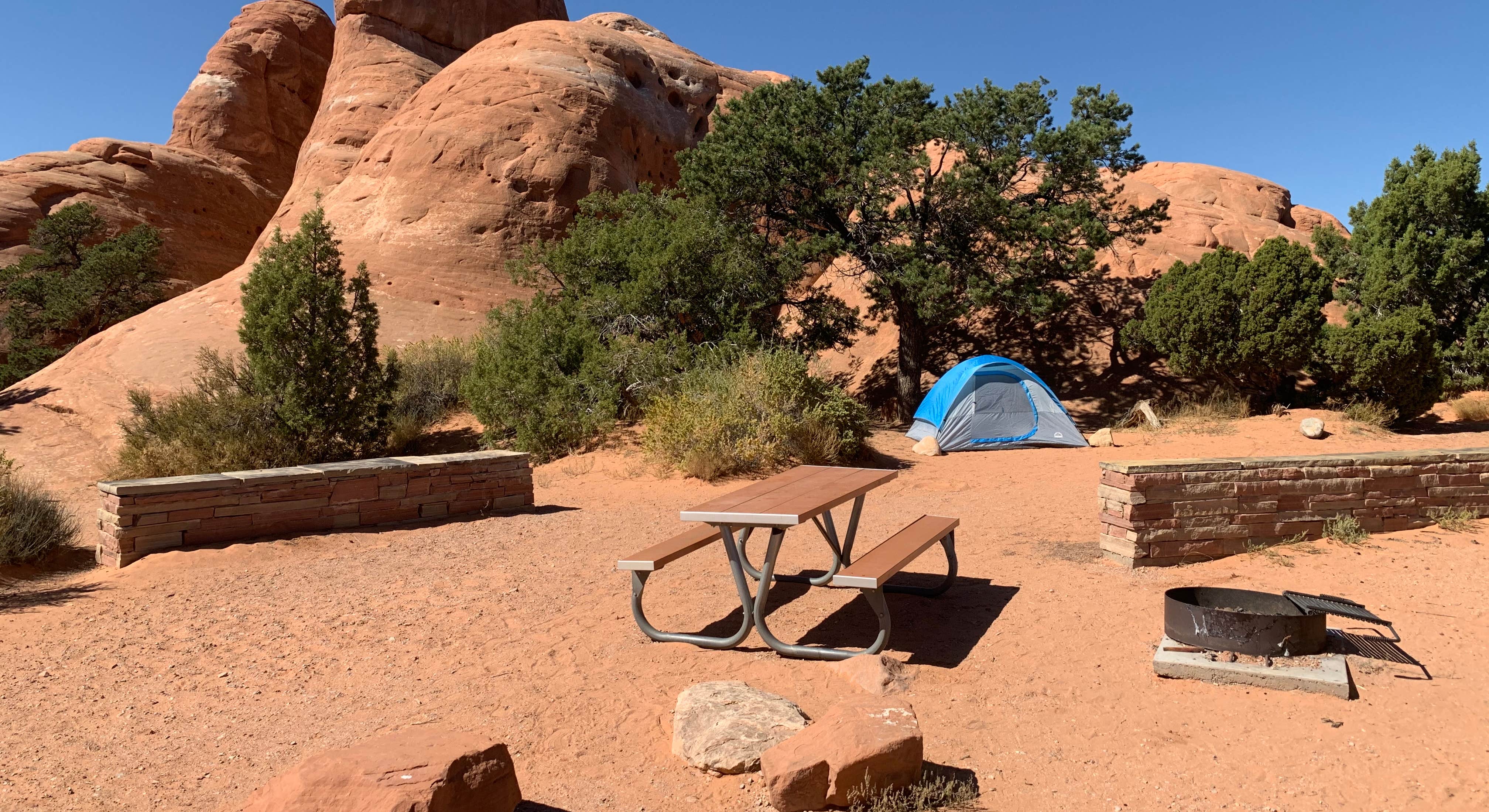 Photo by Olaf I
Photo by Olaf I
Responsible Camping Practices 
Camping in Arches and the surrounding desert comes with a responsibility to protect a fragile ecosystem and respect fellow visitors. The high desert environment can take decades or centuries to recover from damage. By following Leave No Trace principles and park guidelines, you ensure these red rock landscapes remain pristine.
Pack It In, Pack It Out: Everything you bring - from food wrappers to tent stakes - should leave with you. Micro-trash (tiny bits of plastic, bottle caps, bread crusts) is harmful to wildlife. Before departing a campsite, do a thorough sweep for any litter. Do not bury or burn trash. The desert's sparse rainfall means buried trash doesn't decompose and can be dug up by animals. Bring extra trash bags and secure them from animals (raven-proof!) until you can dispose of them in a dumpster.
Stick to Durable Surfaces: The cryptobiotic soil crust ("crypto") is alive and critical for preventing erosion and providing nutrients. One footstep can destroy decades of growth. Stay on established trails, rock, or in sandy washes where footprints won't harm vegetation. In camp, set your tent on bare ground or slickrock, not on grass or biological soil. When dispersed camping near Arches, use existing clearings for tents and parking - don't create new tracks or clearing.
Campfire Responsibility: In developed campgrounds, always use the provided metal fire grill or ring. In dispersed areas, if fires are allowed, use a spot that's been used before (look for a bare patch or existing rock circle). Building new fire rings scars the landscape. Keep your fire modest - a small flame for marshmallows and warmth, not a bonfire. Never collect wood in the park: Dead wood might look tempting, but it serves as shelter and nutrients for desert creatures. It's illegal to gather firewood inside Arches.
Protecting Fragile Soil and Plants: The red-rock country around Arches is crisscrossed with tempting open flats - but driving off designated roads or routes crushes plants and creates long-lasting scars. Only drive on existing roads or marked routes (this is strictly enforced on BLM land too; fines are hefty for off-roading in restricted areas). When parking at a viewpoint or campsite, if the lot is full, do not invent a new spot on vegetation - find another area.
Be a Good Neighbor: Sound travels far in the desert night. Be mindful of generator hours (in Devils Garden, only allowed in Loop A sites, and only during posted hours). Observe quiet hours - other campers may be stargazing or sleeping early to hike at dawn. Use low voices late at night and enjoy the natural silence. Embrace the darkness - excessive campsite lighting blocks your own night vision and affects nearby camps too.
Frequently Asked Questions 
Do I need a timed entry reservation if I'm camping in Arches? No - campers with a Devils Garden Campground reservation (or other in-park permit like a Fiery Furnace ticket or backcountry permit) are exempt from the timed entry system. Simply show your reservation confirmation (printout or on your phone) at the entrance during the restricted hours, and you'll be allowed in. However, if you plan to re-enter on checkout day or visit on a day you're not camping, you would then need a timed entry ticket for entry between 7am and 4pm.
How far ahead should I reserve a campsite at Arches? For peak season (March through October), aim for the full 6 months ahead when reservations open. Devils Garden Campground can fill literally within minutes for popular spring and fall dates. Set a reminder for the date that's six months before your arrival (and note Recreation.gov opens slots at 8:00 AM Mountain Time). If your dates are not flexible or you need multiple sites, definitely book 6 months out.
Are there first-come, first-served campgrounds nearby if I don't have a reservation? Yes, the Moab area has many first-come options. Inside Arches, Devils Garden's 25 winter sites are FCFS. Outside the park, all BLM campgrounds along the Colorado River (Hwy 128 and 279) are first-come (e.g., Goose Island, Grandstaff, Horsethief, etc.). These often fill by mid-morning in spring/fall. There are also first-come sites in Sand Flats Recreation Area (close to Moab). Additionally, dispersed camping on BLM land is unreservable and free but has no amenities.
What's the best time of year to camp at Arches? Fall and spring are generally considered the most comfortable for camping - late September through October offers warm days and cool nights, and April through May is similarly pleasant (though spring sees more wind). These shoulder seasons do have the highest demand. If you prefer fewer crowds and can handle cold nights, winter (November to February) is wonderful for solitude, photography (snow on red rocks), and availability of sites. Summer camping can be very rewarding if you plan correctly (siestas, early hikes), but expect heat and the occasional monsoon storm.
Can I camp anywhere inside the park or do I have to use the campground? In Arches, frontcountry camping is restricted to Devils Garden Campground. You cannot camp in pullouts, parking lots, trailheads, or picnic areas inside the park - rangers will ask you to move, and you could be cited. Backcountry camping within Arches is very limited and only allowed in a few specific zones with a permit (and requires off-trail navigation). For practical purposes, plan to camp either in Devils Garden (if you snag a site) or outside the park on other public lands.
What amenities does Devils Garden Campground have? It is a fairly basic campground with a few welcome amenities. Each site has a picnic table and metal fire ring with grate. There are several flush toilet restroom buildings (with sinks) throughout the campground, and water spigots providing potable water (available roughly March through October - water is turned off in winter to prevent freezing). There are no showers, no electrical or sewer hookups, and no dump station. Trash dumpsters and recycling bins are located near the campground entrance.
Is it safe to leave my campsite to go hike? Will my stuff be okay? Generally yes - the campgrounds around Moab, including Devils Garden, are filled with respectful outdoor enthusiasts. That said, it's wise to practice common sense: secure your valuables out of sight (lock them in your vehicle, or don't bring expensive electronics/jewelry camping). Tent, sleeping bags, stove, etc., are fine left set up at your site. Don't leave food out - not due to people, but animals. Ravens truly might rip into a cooler if left on the picnic table. At Devils Garden, a campground host and park rangers make regular rounds, which adds to security.
Can I bring my RV or trailer? How big of a camper can Arches accommodate? RVs are allowed at Arches campgrounds, but size is the limiting factor. In Devils Garden, the campground loops can handle RVs and trailers up to about 30 feet at most sites (a few sites are listed as accommodating 40ft, but maneuvering can be tight). There are no hookups or dump station in the park, so RV camping there is "dry". Generators are permitted only in Loop A during generator hours. If you have a big rig (35ft+), you might prefer staying at a Moab private RV park which offer pull-thru sites and full hookups.
Are campfires allowed in the summer? Campfire regulations vary with conditions. In general, campfires are allowed in provided rings/grills at Devils Garden and most established campgrounds year-round unless a fire ban is in place. By mid-summer (often July-August), it's common for the state or BLM to issue Stage I fire restrictions, which typically ban open fires except in developed sites. If conditions worsen (extremely dry), Stage II restrictions can ban all open flames, even in campgrounds. Always check the bulletin board or ask a ranger for the current rules when you arrive.
What should I do about food storage in Arches? (Are there bears or critters?) While Arches has no bears, you do need to protect your food from smaller critters. The main culprits are ravens, ground squirrels, chipmunks, mice, and in some areas ringtail cats. These clever creatures will chew through tents, bags, or even cooler lids if something smells tasty. In Devils Garden Campground, there are no bear lockers like in some parks, so it's on you to store things securely. Best practice: keep food inside a hard-sided vehicle when you're away or overnight.
Planning Resources
Essential Arches Links
- The Dyrt Campground Finder for Moab/Arches - Browse user reviews and photos of all Arches NP camping options
- Arches National Park Official Website - Current conditions, park alerts, trail closures, and official maps
- Recreation.gov - Devils Garden Campground - Booking portal for in-park campsites
- Recreation.gov - Arches Timed Entry Tickets - Reserve your timed entry vehicle ticket here
- Discover Moab - Camping Info - Local tourism page with comprehensive list of area campgrounds
- BLM Moab Campgrounds - Information on Bureau of Land Management campgrounds
- Camper's Guide to Arches National Park - Additional tips and insights for camping at Arches
Reservation Timeline
| Time Period | Reservation Task | Platform/Details |
|---|---|---|
| 6 Months Before | Book Devils Garden campground (peak season) | Recreation.gov - mark date 6 months out at 8:00 AM MT Also reserve any Canyonlands or other parks camping if part of trip |
| 3-4 Months Before | Reserve nearby private camp/RV sites if needed | Contact private campgrounds (Moab KOA, Sun Outdoors, etc.) via their websites Spring and fall weekends fill early |
| 2-3 Months Before | Obtain Timed Entry tickets (for park entry) | Initial block releases on Recreation.gov (check schedule: e.g. April tickets release Jan 2) Set calendar alert for release date, 8:00 AM MT |
| 1 Month Before | Reserve rental gear or guided tours | Book Jeep/bike rentals if needed (Moab shops) Secure Fiery Furnace tour (opens 30 days out on Recreation.gov) if desired |
| 1-2 Weeks Before | Check for campground cancellations and weather | Refresh Recreation.gov for any last-minute openings to snag Review forecast - prepare for heat, cold, or storms accordingly |
| Day Before Arrival | Final prep | Print or download entry tickets, camp reservations, permits Buy groceries and water Fill fuel tank |
Arches Camping Checklist
Reservations and Permits:
- Camping reservation confirmation (printed or saved on phone) - Devils Garden or other site
- Timed Entry ticket (if applicable for your entry time) - printed or downloaded
- Photo ID and credit card used for reservations
- National Park Pass or Entrance Fee - have your park pass or $30 entrance fee receipt
- Fiery Furnace or other special permits (if you booked any tours or backcountry permits)
Camping Gear:
- Tent, poles, stakes, guylines (include extra stakes/cord for wind)
- Sleeping bags (rated appropriately for season) and sleeping pads/mattresses
- Camping pillows or pillow cases to stuff clothes in
- Tarp or ground cloth (under tent or as extra shade)
- Sun canopy or reflective shelter (especially for summer trips)
- Camp chairs and folding table (if needed for dispersed camping)
- Headlamps/flashlights (with fresh batteries) - one per person
- Lantern or camp lighting (use sparingly to preserve night sky)
Kitchen and Cooking:
- Camp stove (dual-burner or backpacking stove) and fuel (propane canisters or fuel bottle)
- Cookware - pot, pan, coffee pot (if desired)
- Cooking utensils - spatula, spoon, tongs, knife
- Eating utensils, plates, bowls, cups (durable and reusable to minimize waste)
- Cutting board and knife (with sheath for safety)
- Cooler (with ability to keep ice for a couple of days) and ice or frozen water jugs
- Water containers - e.g. 5-gallon jug, plus personal water bottles/hydration packs
- Biodegradable soap, sponge, and wash basin (if washing dishes)
- Quick-dry dish towel or shammy
- Trash bags (bring multiple - pack out all garbage; double-bag if storing in vehicle)
- Can opener, bottle opener, coffee maker (French press or percolator)
- Aluminum foil (great for cooking packet meals or lining grill)
- Zip-top bags or food storage containers (keep critter-attracting smells sealed)
Food and Essentials:
- Meals planned and packed (with extra non-perishables in case of extended stay)
- Snacks/trail food (nuts, bars, jerky - high-energy foods for hikes)
- Camp spices, oil, condiments (small travel sizes to save space)
- Marshmallows, graham crackers, chocolate - s'mores fixings for the campfire (if fires allowed)
- Plenty of drinking water (if unsure of availability, assume at least 1 gal per person per day)
- Electrolyte packets or sports drinks (helpful in extreme heat to replenish salts)
- Cool treats - consider a watermelon or oranges; hydrating foods are a boon in the desert
Clothing:
- Moisture-wicking base layers (t-shirts, long-sleeve hiking shirts)
- Lightweight long pants (zip-off or breathable fabric) and shorts
- Hiking socks (synthetic or wool; pack extra pairs - sand will infiltrate)
- Sun hat (wide brim or legionnaire style that covers neck)
- Bandana or Buff (multi-use for sweat, sun protection, even cooling when dipped in water)
- Warm layers - fleece or insulated jacket for evenings, beanie and gloves (especially fall-spring)
- Rain jacket or windbreaker (storms can surprise even in arid climate)
- Sturdy hiking boots or shoes (broken-in to avoid blisters) and/or camp shoes (sandals or flip-flops)
- Swimsuit (if planning on river dips or hitting the Moab pool/shower)
- Work gloves (optional - helpful when handling firewood)
Personal Items:
- High-SPF sunscreen (and lip balm with SPF) - apply and reapply often
- Sunglasses (UV-protective; the sun and red rock glare are intense)
- Insect repellent (generally only needed near water or after rare rains)
- Toiletries (toothbrush/paste, biodegradable soap, hand sanitizer, toilet paper)
- WAG bags or portable toilet (if dispersed camping or during fire bans when catholes are disallowed)
- First aid kit - include bandages, moleskin (for blisters), antiseptic wipes, tweezers (splinters or cactus spines), pain relievers, any personal medications
- Allergy meds (spring blooms or dust can trigger allergies)
- Camera or smartphone (with extra batteries or power bank for charging)
- Navigation tools - map of park, compass, and/or GPS device
- Emergency whistle (and mirror - small lightweight signals if needed)
- Cash (small bills for self-pay campgrounds, firewood, etc.)
- Guidebook or star chart (enrich your experience by learning about geology, constellations)
By planning carefully, packing thoughtfully, and camping responsibly, you'll create lasting memories under Utah's brilliant skies. Whether watching the sunset paint the red rocks gold or gazing at the Milky Way as a cool night breeze drifts through camp, camping at Arches National Park offers an unforgettable desert experience. For those seeking alternative camping experiences, consider exploring cabin rentals near Arches, glamping options around Arches National Park, or horse camping near Arches for a different perspective on this incredible landscape. The surrounding areas also offer excellent camping, including Zion National Park, Capitol Reef National Park tent camping, and Bryce Canyon glamping. Happy camping beneath the arches!

